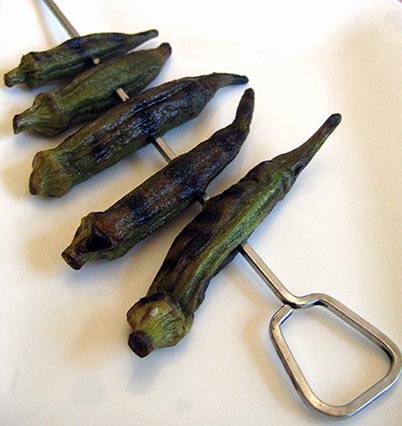 I have now spent 14 years trying to get people to eat their vegetables in Prairieland Community Supported Agriculture. Like the adage that a weed is a plant that you haven’t found something constructive to do with yet, I believe the same applies to vegetables. If you don’t like a vegetable, it’s because there is a recipe out there that you haven’t tried it in yet.
I have now spent 14 years trying to get people to eat their vegetables in Prairieland Community Supported Agriculture. Like the adage that a weed is a plant that you haven’t found something constructive to do with yet, I believe the same applies to vegetables. If you don’t like a vegetable, it’s because there is a recipe out there that you haven’t tried it in yet.
Unfortunately, okra is at the top of that list for many people. Many people view it as stringy and/or slimy. Young okra is actually neither, but in hot humid conditions like this year, it seems to grow inches overnight, leaving you with pods as long as your finger instead of the knuckle length ones prized in the Middle East.
The problem is that the older the pods are, the more likely they are to be tough, and, the more likely they are to have a mucilaginous quality when sliced. This is fine for gumbo as it helps to thicken the soup, but disastrous for fried okra, which is how most people eat okra in the U.S., especially in the south. There, it is sliced, salted, tossed in cornmeal, and shallow fried in a heavy skillet. Frankly, this dish is only good if you have your own okra patch and are maniacal about picking it tender and are willing to wait for the salt to draw out the water and the cornmeal to adhere to the slices which turns the process into an hour-long affair.
This is why a lot of restaurants batter and deep fry okra. If you haven’t had fried okra at JJ’s or Seaboat, I believe you are missing out. But then, I have always liked okra. For people who don’t like okra, there are two excellent options: grilling and Indian-style okra.
I learned about grilling okra this summer from my oldest sister, who has her own okra patch, but also has a life. Grilling makes the okra tender and eliminates any sliminess, even if the pods are a little bigger or they have sat in the fridge for a couple of days. We didn’t get around to grilling the okra she gave us for a week and it was still great. To grill okra, brush it with oil. Sprinkle it with salt and put it perpendicular to the grates over direct heat for four minutes per side. Smaller pieces will cook a bit more quickly, so watch them. The result is amazing.
In India, okra is called ladyfinger, bhindi or bhendi. This is my version of a dish I had in northwest India several years ago. If you have garam masala, you can a half teaspoon to teaspoon, as well. A sliced green chile also is a nice addition if you prefer a spicier dish.
Indian-style Okra
- 2 large onions, peeled and chopped
- 3 T butter
- 3-4 cloves garlic minced
- pinch of salt
- dash black pepper
- dash cumin
- dash cayenne (optional)
- 1 1/2 t paprika
- 2 1/2 t ground coriander
- 1/2 t tumeric
- 1 lb okra sliced 1/4-inch to 3/8-inch thick
- 8 oz canned tomatoes or equivalent fresh
- 1 T chopped fresh cilantro
Saute onions in butter until just soft. Add garlic, spices, and chile, if using. Cook until fragrant, stirring constantly. Add okra and stir. Add tomatoes and cilantro. Simmer gently uncovered until okra is tender and tomatoes form a sauce. Adjust salt. Serve.








